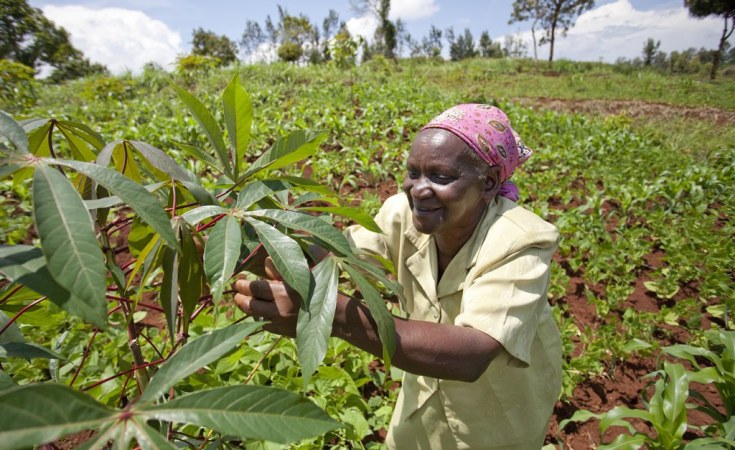Kiamwangi, Kenya — If growing up in an agricultural community were the key to health, the children of Kiamwangi would be thriving. But Jane Hunyu, who farms a quarter-acre plot here, says the children in her region are nearly as frail as their grandparents.
Most of the youth in this central Kenyan village work in the foreign-owned horticultural farms that have sprung up along the highway linking rural Kenya with the capital, Nairobi. Others have either joined extortion gangs, or are in the hawking business, says Hunyu.
While the farms grow fresh fruits and vegetables for export, health centers in Hunyu's village continue to treat diseases related to nutritional deficiency.
"Children are malnourished," says Hunyu. "Recently, we are also seeing increasing cases of diabetes." She concludes that the children's families cannot afford the produce they harvest with their own hands. It's a dilemma facing millions of agricultural workers in Africa, and few know any other way of life.
Hunyu had noticed that many small-scale farmers had started growing crop varieties like those produced by big commercial farms.
"This required us to buy fertilizers, pesticides and other farm inputs to ensure a good harvest," says Hunyu, a mother of two. "But the crops started failing due to erratic rainfall and many farmers were left desperate."
But unlike some farmers who have never left their rural village, Hunyu was able to glimpse a different agricultural system during a 2010 trip to the United States to visit her sister. And what she saw offered a possible solution to this nutritional challenge. She learned about the growing demand for organic foods, and that some of the produce came from her home country.
Hunyu returned to Kenya determined to change small-scale farming by reclaiming the traditional practice of growing local crop varieties, which researchers say are more nutritious and better able to survive in extreme weather.
Hunyu also hoped for a bonus: the practice just might give the children from her village a healthier start.
Under the Songa Mbele Community Development Initiative (Somcodi), farmers are being encouraged to go back to growing indigenous crops such as arrowroot, sweet potatoes, bananas, yams, sorghum, cowpeas, millet and cassava.
Leaders at Somcodi, an initiative of some 360 groups in Kenya, are certain that products processed from the foods, such as flour and juices, are also affordable.
"The value-added products are easy to use and protect the village economy," says Sister Veronica Thiga, the officer in charge at Somcodi.
With some 9,000 farmers in Kenya already applying the skills learned from Somcodi, there is hope that traditional staple foods may help improve nutrition. The Ministry of Public Health and Sanitation says this could save close to U.S.$35 million in health care costs.
Malnourishment causes stunting, a reduced growth rate. Data from the 2009 Kenya Demographic and Health Survey indicate that nationally, 35 percent of children under five are stunted, while 14 percent are severely stunted.
Globally, a recent report from the Save the Children charity estimated that half a billion children could grow up physically and mentally stunted over the next 15 years because of poor diet. Most of these children live in developing countries where key food groups such as meat, milk and vegetables are becoming increasingly unaffordable for the poor.
For families living in the arid and semi-arid areas of Kenya, there have been efforts to provide relief food through humanitarian organizations. But in regions where farming is widespread, little is being done to support the livelihoods of those who depend on traditional agricultural systems - many of which are failing.
Some experts say climate change is at least partly to blame, but studies also show that large-scale agriculture has been undercutting small farmers.
The International Institute for Environment and Development links this trend to the cultivation of bio-fuel plants and commercial farming of staple food. The demand for alternative energy and organic foods in Europe and the United States is the driving factor.
Furthermore, trade barriers have made the South-to-North flow of food expensive, and as a new report indicates, food prices in Africa have remained high amid a global decline. The report by the Alliance for a Green Revolution recommends "high-payoff, low-cost" solutions, such as better post-harvest facilities and easy access to credit, among other subsidies.
But other researchers believe that developing superior strains of traditional food varieties could not only improve rural health, but also the local economy.
"Kenyans should start reaching out to traditional staple foods such as finger millet, because our studies show that they are richer in nutrients for both mothers and children," says Clement Kamau, a researcher with the Kenya Agricultural Research Institute.
Researchers are rallying behind this shift for an important reason. They say that historically these varieties have been considered the 'poor man's crops'.
The International Crop Research Institute for the Semi Arid Tropics (Icrisat) is contributing to this effort through the recent development of a commercially sustainable Sorghum for Multiple Uses value chain in Kenya and Tanzania.
Says Said Silim, Icrisat director for eastern and southern Africa: "Farmers will benefit from capacity-building in sustainable sorghum production, access to quality seeds of improved multiple uses sorghum varieties and establish linkages to markets."
-------------------------------------------------------------------------------------------------------
AllAfrica and the Institute of Development Studies in the United Kingdom are collaborating on a research-driven reporting series that looks at how evidence-based innovations can save lives, transform communities and promote equitable economic development in Africa.
------------------------------------------------------------------------------------------------------


